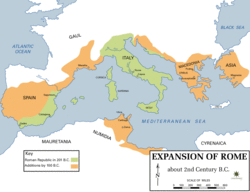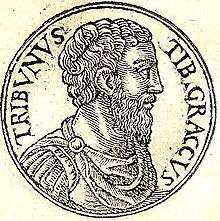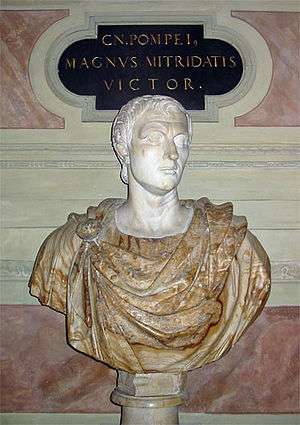Crisis of the Roman Republic
 |
| This article is part of a series on the politics and government of Ancient Rome |
| Periods |
|
| Roman Constitution |
| Ordinary magistrates |
| Extraordinary magistrates |
| Titles and honours |
| Precedent and law |
|
|
| Assemblies |
The Crises of the Roman Republic refers to an extended period of political instability and social unrest that culminated in the demise of the Roman Republic and the advent of the Roman Empire, from about 134 BC to 44 BC.
The exact dates of the Crisis are unclear because "Rome teetered between normality and crisis" for many decades.[1]
Likewise, the causes and attributes of the crises changed throughout the decades, including the forms of slavery, brigandage, wars internal and external, land reform, the invention of excruciating new punishments,[2] the expansion of Roman citizenship, and even the changing composition of the Roman army.[3]
Modern scholars also disagree about the nature of the crisis. Traditionally, the expansion of citizenship (with all its rights, privileges, and duties) was looked upon negatively by Sallust, Gibbon, and others of their schools, because it caused internal dissension, disputes with Rome's Italian allies, slave revolts, and riots.[4] However, other scholars have argued that as the Republic was meant to be res publica—the essential thing of the people—the poor and disenfranchised can not be blamed for trying to redress their legitimate and legal grievances.[4]
Dating the crisis

For centuries, historians have argued about the start, specific crises involved, and end date for the Crisis of the Roman Republic. As a culture (or "web of institutions"), Florence Dupont and Christopher Woodall wrote, "no distinction is made between different periods."[5] However, without question, the Romans lost liberty through plunder, by "their morally undermining consequences."[6]
Arguments for an early start-date (c. 134 to 73 BC)
Harriet I. Flower and Jurgen Von Ungern-Sternberg argue for an exact start date of 10 December 134 BC, with the inauguration of Gracchus as tribune,[7] or alternately, when he first issued his proposal for land reform in 133 BC.[8] Appian of Alexandria wrote that this political crisis was "the preface to... the Roman civil wars".[9] Velleius commentated that it was Gracchus' unprecedented standing for re-election as tribune in 132 BC, and the riots and controversy it engendered as the start of a crisis:
This was the beginning of civil bloodshed and of the free reign [sic] of swords in the city of Rome. From then on justice was overthrown by force and the strongest was preeminent.— Velleius, Vell. Pat. 2.3.3–4, translated and cited by Harriet I. Flower[10]
In any case, the assassination of Tiberius Gracchus in 133 BC marked "a turning point in Roman history and the beginning of the crisis of the Roman Republic."[11]
Barbette S. Spaeth specifically refers to "the Gracchan crisis at the beginning of the Late Roman Republic"...[12]
Nic Fields, in his popular history of Spartacus, argues for a start date of 135 BC with the beginning of the First Slave War in Sicily.[13] Fields asserts:
The rebellion of the slaves in Italy under Spartacus may have been the best organized, but it was not the first of its kind. There had been other rebellions of slaves that afflicted Rome, and we may assume that Spartacus was wise enough to profit by their mistakes.— Nic Fields[14]
The start of the Social War (91–88 BC), when Rome fought her nearby Italian neighbours, may be thought of as the beginning of the end of the Republic.[15][16] Fields also suggests that things got much worse with the Samnite engagement at the Battle of the Colline Gate (82 BC) around 82 BC.[17]
Barry Strauss argues that the crisis really started with "The Spartacus War" in 73 BC, adding that, because the dangers were unappreciated, "Rome faced the crisis with mediocrities".[18]
Arguments for a later start date (69 to 44 BC)
Thornton Wilder, in his novel, The Ides of March, focuses on the period c. 69 BC to 44 BC as the Crisis. Pollio and Ronald Syme date the Crisis only from the time of Julius Caesar in 60 BC.[19] Caesar's crossing of the Rubicon in 49 BC has become the clichéd point of no return for the Republic, as noted in many books, including Tom Holland's Rubicon: The Last Years of the Roman Republic.[20]
Arguments for an end date (49 to 27 BC)
The end of the Crisis can likewise either be dated from the Assassination of Julius Caesar on 15 March 44 BC, after he and Sulla did so much "to dismantle the government of the Republic,"[21] or alternately when Octavian took on the name of Augustus and founded the Roman Empire in 27 BC.[22] The end could also be dated earlier, at the time of the Constitutional Reforms of Julius Caesar in 49 BC.
Tiberius and Gaius Gracchus

Tiberius Gracchus took office as a tribune of the plebs in late 134 BC while "everything in the Roman Republic seemed to be in fine working order."[23] There were a few apparently minor problems, such as "the annoyance of a slave revolt in Sicily".[24]
At the same time, Roman society was a highly stratified class system whose divisions were bubbling below the surface. This system consisted of noble families of the senatorial rank, the knight or equestrian class, citizens (grouped into two or three classes depending on the time period - self-governing allies of Rome, landowners, and plebs or tenant freemen), non-citizens who lived outside of southwestern Italy, and at the bottom, slaves. By law, only men who were citizens could vote in certain assemblies, and only those men who owned a certain amount of real property could serve in the military, which would gain them social prestige and additional benefits of citizenship.[25] The government owned large tracts of farm land that it had gained through invasion or escheat, and rented out to large landowners, whose slaves tilled their land, or who sub-leased to small tenant farmers.[26] There was some social mobility and limited suffrage.[27] The plebs (or plebeians) were a socio-economic class, but also had possible origins as an ethnic group with its own cult to the goddess Ceres, and ultimately, were a political party during much of the Roman Republic.[28]
Normally, the Senate had the sole power to pass legislation, and only members of the upper classes, such as former magistrates, were eligible to run for and serve in the Senate.
Beginning in 133 BC, Gracchus tried to redress the grievances of displaced smallholders. He bypassed the Roman senate and passed a law limiting the amount of land belonging to the state that any individual could farm.[29] This would have resulted in the breakup of the large plantations maintained by the rich on public land and worked by slaves.[29]
Gracchus' moderate plan of agrarian reform was motivated "to increase the number of Roman citizens who owned land and consequently the number who would qualify as soldiers according to their census rating."[29] The plan included a method to quiet title, and had a goal of increasing the efficiency of farmland, while doling out small parcels of land to tenant farmers, his populist constituency.[29] Gracchus knew of a loophole—the lex Hortensia of 287 BC allowed the assembly of plebs to bypass the Senate.[29] However, another tribune, Marcus Octavius, used his veto to scuttle the plan.[29]
The crisis escalated: Gracchus pushed the assembly to impeach and remove Octavius; the Senate denied funds to the commission needed for land reform; Gracchus then tried to use money out of a trust fund left by Attalus III of Pergamum; and the Senate blocked that, too.[30] At one point, Gracchus had "one of his freedmen... drag Octavius from the speaker's platform."[31] This assault violated the Lex sacrata, which prohibited people of lower status from violating the person of a person of higher class.[31] Rome's unwritten constitution hampered reform.[29] So Gracchus sought re-election to his one-year term, which was unprecedented in an era of strict term limits.[32] The oligarchic nobles responded by murdering Gracchus,[33][34] and mass riots broke out in the city in reaction to the assassination.[35]
Barbette Stanley Spaeth asserts that Ceres' roles as (a) patron and protector of plebeian laws, rights and Tribunes and (b) "normative/liminal" crimes, continued throughout the Republican era.[12] These roles were "exploited for the purposes of political propaganda during the Gracchan crisis...."[12]
Ceres' Aventine Temple served the plebeians as cult centre, legal archive, treasury, and court of law, founded contemporaneously with the passage of the Lex sacrata;[12] the lives and property of those who violated this law were forfeit to Ceres, whose judgment was expressed by her aediles.[36] The official decrees of the Senate (senatus consulta) were placed in her Temple, under her guardianship; Livy bluntly states this was done so that the consuls could no longer arbitrarily tamper with the laws of Rome.[37] The Temple might also have offered asylum for those threatened with arbitrary arrest by patrician magistrates.[38] Ceres was thus the patron goddess of Rome's written laws; the poet Vergil later calls her legifera Ceres (Law-bearing Ceres), a translation of Demeter's Greek epithet, thesmophoros.[39] Those who approved the murder of Tiberius Gracchus in 133 BC justified his death as punishment for his offense against the Lex sacrata of the goddess Ceres: those who deplored this as murder appealed to Gracchus' sacrosanct status as tribune under Ceres' protection.[12] In 70 BC, Cicero refers to this killing in connection with Ceres' laws and cults.[12][40][41]
Spaeth believed that he was killed because:
Tiberius Gracchus had transgressed the laws that protected the equilibrium of the social and political order, the laws on the tribunician sacrosanctitas and attempted tyranny, and hence was subject to the punishment they prescribed, consecration of his goods and person [to Ceres].— Barbette S. Spaeth, The Roman goddess Ceres, p. 74.[42]
Rather than attempting to atone for the murder, the Senate used a mission to Ceres' temple at Henna (in Sicily) to justify his execution.[42] The agrarian reforms were only partially implemented by the commission; yet Gracchi colonies were set up both Italy and Carthage.[43]
About nine years later Tiberius's younger brother, Gaius, passed more radical reforms. In addition to settling the poor in colonies on land conquered by Rome, he passed the lex frumentaria, which gave the poor the right to buy grain at subsidized prices.[44]
In the past, the senate eliminated political rivals either by establishing special judicial commissions or by passing a senatus consultum ultimum ("ultimate decree of the senate").[45][46] Both devices allowed the senate to bypass the ordinary due process rights that all citizens had.[47]
Some of Gaius' followers caused the death of a man, which allowed his political rival, Lucius Opimius, to suspend the constitution again with another senatus consultum ultimum.[48]
Gaius fled, but he was also probably murdered by the oligarchs.[33] According to one ancient source, Gaius was not killed directly by them, but ordered his slave Philocrates to do the deed in a murder-suicide.[49]
Gaius Marius and Sulla
The next major reformer of the time was Gaius Marius, who like the Gracchi, was a populist.[4] Unlike them, he was also a general.[4][50] He abolished the property requirement for becoming a soldier.[4][50] The poor enlisted in large numbers.[4][50] This opening of the Army's ranks to the capite censii enfranchised the plebs, thus creating an esprit de corps in the enlarged army.[4][51] Some elites complained that the army now became unruly due to the commoners in its ranks, but this is without good cause:[4][51]
Marius stands accused of paving the way for the so-called lawless, greedy soldiery whose activities were thought to have contributed largely to the decline and fall of the Republic a few generations later. Yet we should not lose sight of the fact that Marius was not the first to enrol the capite censi. Rome was ruled by an aristocratic oligarchy embedded in the Senate. Thus at times of extreme crisis in the past the Senate had impressed them, along with convicts and slaves, for service as legionaries.— Nic Fields[4]
Marius employed his soldiers to defeat an invasion by the Germanic Cimbri and Teutons.[50] His political influence and military leadership allowed him to obtain six terms as consul in 107, and 103 to 99 BC.[50] In 99 BC, the senate used renewed violence to declare another senatus consultum ultimum.[50]
Sulla, who was appointed as Marius' quaestor in 107, later contested with Marius for supreme power. In 88, the senate awarded Sulla the lucrative and powerful post of commander in the war against Mithridates over Marius. However, Marius managed to secure the position anyway, through political deal-making with Publius Sulpicius Rufus. Sulla initially went along, but finding support among his troops, seized power in Rome and marched to Asia Minor with his soldiers anyway. There, he fought a largely successful military campaign and was not persecuted by the senate. Marius himself launched a coup with Cinna in Sulla's absence and put to death some of his enemies. He instituted a populist regime, but died soon after.[52]
Sulla made peace with Rome's enemies in the east and began to arrange for his return to Rome. Cinna, Marius's populist successor, was killed by his own men as they moved to meet Sulla on foreign soil. When Sulla heard of this, he ceased negotiations with Rome and openly rebelled in 84. Invading the peninsula, he was joined by many aristocrats including Crassus and Pompey and defeated all major opposition within a year. He began a dictatorship and purged the state of many populists through proscription. A reign of terror followed in which some innocents were denounced just so their property could be seized for the benefit of Sulla's followers. Sulla's coup resulted in a major victory for the oligarchs. He reversed the reforms of the Gracchi and other populists, stripped the tribunes of the people of much of their power and returned authority over the courts to the senators.[53]
Pompey

Pompey the Great, the next major leader who aggravated the crisis, was born Gnaeus Pompeius, but took his own cognomen of Magnus ("the Great").[54] Pompey as a young man was allied to Sulla,[55] but in the consular elections of 78 BC, he supported Lepidus against Sulla's wishes. When Sulla died later that year, Lepidus revolted, and Pompey suppressed him on behalf of the senate. Then he asked for proconsular imperium in Hispania, to deal with the populares general Quintus Sertorius, who had held out for the past three years against Quintus Caecilius Metellus Pius, one of Sulla's most able generals.[56]
Pompey's career seems to have been driven by desire for military glory and disregard for traditional political constraints.[57] Pompey served next to Crassus and Julius Caesar as part of the first triumvirate of Rome, however, before this, the Roman aristocracy turned him down— as they were beginning to fear the young, popular and successful general. Pompey refused to disband his legions until his request was granted.[58] The senate acceded, reluctantly granted him the title of proconsul and powers equal to those of Metellus, and sent him to Hispania.[59]
Pompey infamously wiped out what remained of Spartacus' troops in 71 BC, who had been pinned down by Marcus Crassus.[60] He received Rome's highest honor, the triumph, while Crassus only received the honorable mention of an ovation, which hurt Crassus' pride.[61]
In 69 BC, he conquered Syria, defeated King Tigranes of Armenia, and replaced one puppet king, Seleucus VII Philometor with his brother Antiochus XIII Asiaticus.[54] Four years later, he deposed the monarchy, replacing it with a governor.[54] This not only finished off the Seleucids,[62] but brought in thousands of slaves and strange peoples, including the Judeans, to Rome, thus creating the Jewish diaspora.[55] This generated swarms of refugees, which can only have created its own discord.
While many of Pompey's reckless actions ultimately increased discord in Rome, his unlucky alliance with Crassus and Caesar is cited as being especially dangerous to the Republic.[19]
See also
- Damnatio memoriae
- The History of the Decline and Fall of the Roman Empire by Edward Gibbon
- Rise of Rome
References
- ↑ Flower, p. 103, n. 58, citing Gruen 1974 and Meier 1997, pp. 7–23.
- ↑ The root of excruciating means from crucifixion. See Fields, p. 79.
- ↑ Fields, pp. 8, 18–25, 35–37.
- 1 2 3 4 5 6 7 8 9 Fields, p. 41, citing Sallust, Iugurthinum 86.2.
- ↑ Dupont, p. ix.
- ↑ Dupont, p. x.
- ↑ Flower 2004, p. 89.
- ↑ Flower 2004, pp. 90-92.
- ↑ Flower, p. 89, citing Appian.
- ↑ Flower, p. 91.
- ↑ Flower, p, 92.
- 1 2 3 4 5 6 Spaeth (1996), p. 73.
- ↑ Fields, p. 7, 8-10.
- ↑ Fields, p. 7.
- ↑ Flower, p. 97.
- ↑ Fields, pp. 12, 24.
- ↑ Fields, pp. 19-20.
- ↑ Strauss, p. 96.
- 1 2 Syme, p. 16, wrote that Pollio "made his history of the Civil Wars begin not with the crossing of the Rubicon, but with the compact between Pompey, Crassus, and Caesar...." Found at Google Books. Accessed February 7, 2011.
- ↑ Tom Holland, Rubicon: The Last Years of the Roman Republic (Anchor Books 2003). ISBN 1-4000-7897-0.
- ↑ Flower, pp. 85, 366.
- ↑ Flower, p. 366.
- ↑ Flower, p. 89
- ↑ Flower, p. 89, see also Fields, pp. 7-10.
- ↑ Fields, p. 41; Flower, pp. 90–91, 93; Dupont, pp. 40–41, 45–48.
- ↑ Flower, pp. 90-91
- ↑ Flower, p. 89, nn. 2, 3, citing various scholars discussions (citations omitted).
- ↑ For a further discussion of the plebs and Ceres, see Spaeth (1996), pp. 6–10, 14–15, and 81–102 (Chapter 4 of that treatise), citing R. Mitchell, Patricians and Plebeians: The Origin of the Roman State (Ithaca and London 1990).
- 1 2 3 4 5 6 7 Flower, p. 90.
- ↑ Flower, pp. 90-91.
- 1 2 Spaeth (1996), p. 75.
- ↑ Flower, pp. 89, 91.
- 1 2 Strauss, p. 204-205
- ↑ Spaeth (1996), pp. 74-75.
- ↑ Flower, pp. 91-92.
- ↑ For discussion of the duties, legal status and immunities of plebeian tribunes and aediles, see Andrew Lintott, Violence in Republican Rome, Oxford University Press, 1999,pp. 92–101, and Spaeth, pp. 85-90.
- ↑ Livy's proposal that the senatus consulta were placed at the Aventine Temple more or less at its foundation (Livy, Ab urbe condita, 3.55.13) is implausible. See Spaeth (1996) p.86–87, 90.
- ↑ The evidence for the temple as asylum is inconclusive; discussion is in Spaeth, 1996, p.84.
- ↑ Cornell, T., The beginnings of Rome: Italy and Rome from the Bronze Age to the Punic Wars (c. 1000–264 BC), Routledge, 1995, p. 264, citing vergil, Aeneid, 4.58.
- ↑ David Stockton, Cicero: a political biography, Oxford University Press, 1971, pp. 43–49. Cicero's published account of the case is usually known as In Verrem, or Against Verres.
- ↑ Cicero, Against Verres, Second pleading, 4.49–51:English version available at wikisource.
- 1 2 Spaeth (1996), p. 74, fn. 84, pp. 204-205, citing Cicero, Dom. 91, et al..
- ↑ Dupont, pp. 45-46, 48.
- ↑ Flower, p. 93
- ↑ Polybius, 133
- ↑ Polybius, 136
- ↑ Abbott, 98
- ↑ Flower, p. 94, citing J. von Ungern-Sternberg, Unter suchungen: senatus consultum ultimum, pp. 55-57 (Munich 1970) and W. Nippels, Public order in ancient Rome, pp. 57-69 (Cambridge 1995).
- ↑ Dupont, p. 58, n. 29, citing Valerius maximus, Works, VI.8.5.
- 1 2 3 4 5 6 Flower, pp. 95-96.
- 1 2 See also Fields, pp. 12, 46.
- ↑ Roberts, John (2007). Oxford Dictionary of the Classical World. Oxford, England: Oxford University Press. pp. 187–188, 450–451. ISBN 978-0-19-280146-3.
- ↑ Roberts, John (2007). Oxford Dictionary of the Classical World. Oxford, England: Oxford University Press. pp. 187–188, 450–451. ISBN 978-0-19-280146-3.
- 1 2 3 Losch, p. 390.
- 1 2 Losch, p. 349.
- ↑ Fields, q.v., get p. #
- ↑ Holland, Tom, Rubicon: The Triumph and Tragedy of the Roman Republic, pp. 141–42 (Abacus, London, 2004). ISBN 0-349-11563-X.
- ↑ Plutarch, Parallel Lives, Life of Pompey, p. 158 (Loeb Classical Library, 1917).
- ↑ Boak, Arthur E.R. A History of Rome to 565 A.D., p. 152 (MacMillan, New York, 1922).
- ↑ Losch, p. 349; Fields, pp. 71-81.
- ↑ Fields, pp. 81-82; Losch, p. 349; Strauss, pp. 195-200.
- ↑ Losch, pp. 379-390, 575.
Major sources and further reading
- Abbott, Frank Frost (1901). A History and Description of Roman Political Institutions. Elibron Classics. ISBN 0-543-92749-0.
- P.A. Brunt, The Fall of the Roman Republic and Related Essays (Oxford: Clarendon Press, 1988) ISBN 978-0-19-814849-4.
- Florence Dupont (translated by Christoper Woodall), Daily Life in Ancient Rome (Oxford UK and Cambridge USA: Blackwell, 1992) ISBN 0-631-17877-5.
- Shmuel Noah Eisenstadt and Luis Roniger, Patrons, clients, and friends: interpersonal relations and the structure of trust in society, "Themes in the social sciences" series (Cambridge University Press, 1984) ISBN 978-0-521-28890-3
- Nic Fields, Spartacus and the Slave war 73-71 BC: A gladiator rebels against Rome (Osprey 2009) ISBN 978-1-84603-353-7 (an easy read for young adults and college students)
- Harriet I. Flower, ed., The Cambridge Companion to the Roman Republic (Cambridge University Press, 2004) ISBN 978-0-521-00390-2 (Found at Google Books). This book includes the essay by Jurgen Von Ungern-Sternberg (translated by Harriet I. Flower), "The Crisis of the Roman Republic," pp. 89–109.
- E. S. Gruen, The last generation of the Roman Republic (Berkeley 1974).
- Richard R. Losch, All the People in the Bible: An A–Z Guide to the Saints, Scoundrels and Other Characters in Scripture (William B. Erdmans 2008). ISBN 978-0-8028-2454-7.
- Pamela Marin, Blood in the forum: the struggle for the Roman republic (New York: Continuum 2009) Dewey # 937.07M. ISBN 978-1-84725-167-1
- Christian Meier, Caesar: A Biography, afterward pp. 481–496 (Basic Books, 1997) ISBN 978-0-465-00895-7
- Christian Meier, Res publica Amissa: eine Studie zur Verassung und Geschichte der spaten romischen Republik (3rd ed. Frankfort, 1997)
- Polybius (1823). The General History of Polybius: Translated from the Greek. Vol 2 (Fifth ed.). Oxford: Printed by W. Baxter.
- Robin Seager, ed., Crisis of the Roman Republic: Studies in political and social history (W. Heffner & Sons, Ltd. 1969) ISBN 978-0-85270-025-9 (soft cover) and ISBN 978-0-85270-024-2 (hardcover).
- Barbette Spaeth (1996). The Roman Goddess Ceres. U. of Texas Press. ISBN 0-292-77693-4.
- Barry Strauss, The Spartacus War (Simon and Schuster 2009) ISBN 978-1-4165-3205-7
- Ronald Syme, The provincial at Rome: and, Rome and the Balkans 80BC–AD14 (original ed. Liverpool University Press, 1939) Anthony Birley, ed. (University of Exeter Press, 1999). ISBN 978-0-85989-632-0.
- Timothy Peter Wiseman, Remembering the Roman People: Essays on Late-Republican Politics and Literature (Oxford University Press US, 2009) ISBN 978-0-19-923976-4.
External links
- Rome:crisis of the State from Washington State University website
- Works by Sallust at Project Gutenberg (Schmitz and Zumpt, 1848): Bellum Iugurthinum
